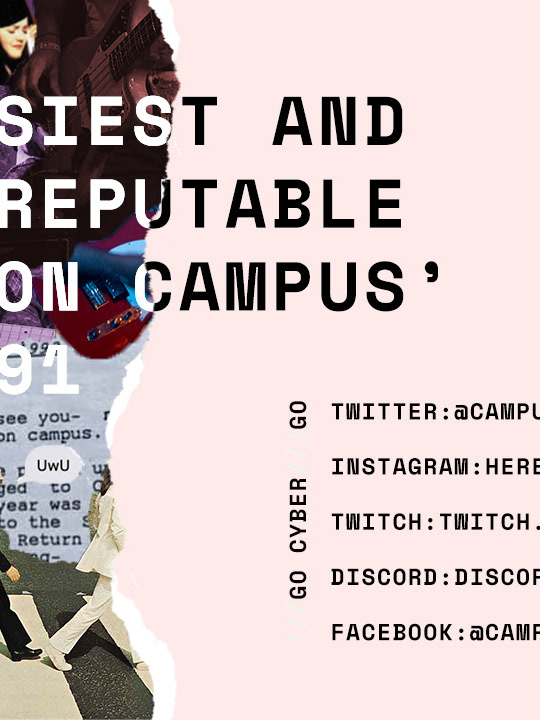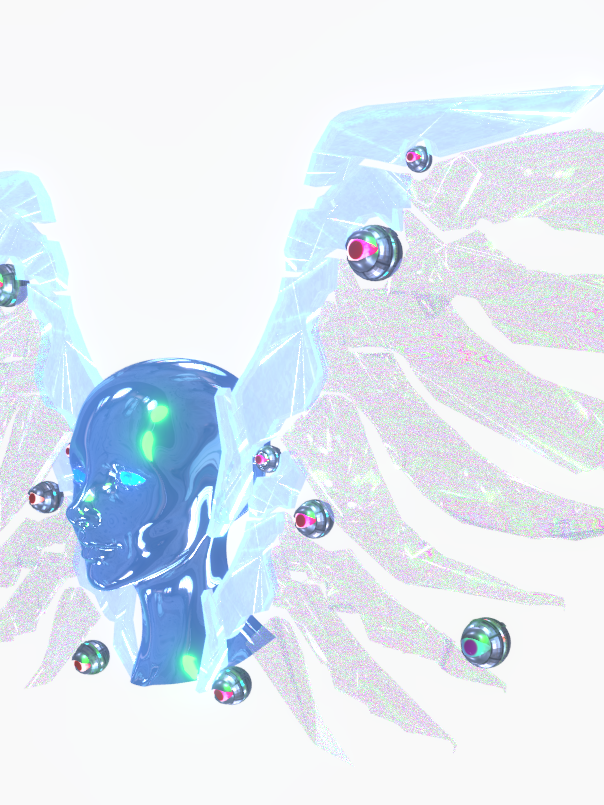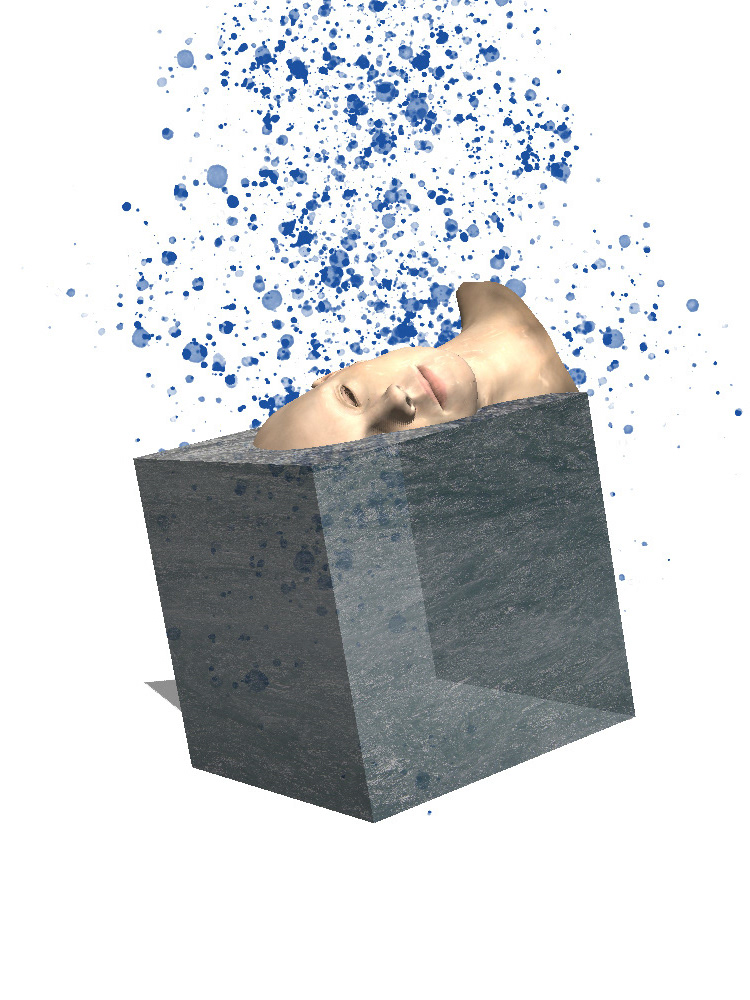How does one empower queer and marginalised people in storytelling, in the age of social media? This is a question that I often reflect on as a heavy social media user, a queer person, and a creative. The idea for my project was created in my exploration of this question.
The prototype and the production process of the gamified erotic film Mason Jar Lover explores a storytelling approach that serves the agency of marginalised people. This critical context will first illustrate the theoretical framework that supported the project, which includes theories and studies on immersive storytelling, abjection, queerness, and agency. It then reflects and analyses the creative practice, which was a significant failure in comparison to my original expectations. Still, the project also resulted in learning and demonstrated potential across disciplines.
The project introduces a series of gamified erotic 3D animation films, which would be published independently through an app or website. The 3D models, film footage and gaming experiences are produced with Blender and Unreal Engine. The films themselves contain no/minimum sexually explicit content – they focus on providing an interactive erotic experience. Viewers can make their decisions to change the movie, while the film integrates a scripted remote control to the viewer’s sex toy. In order to cooperate with a community, this project research on Twitch as I live stream the production of the project.
*Below is a playthrough of the demo. I can't show everything here due to the number and size of the files. I covered my face cam due to... considerations. Contact me if you're interested in learning more about it.*
The long and boring explanation on Mason Jar Lover, clipped from my dissertation submission:
Mason Jar Lover & Production Process
The experience of Mason Jar Lover starts with a TV showing an advert for ‘MagiScoby’, followed by a music program playing the theme song of Mason Jar Lover, both stylised in a retro visual effect. The advert introduces a trash-composting scoby that claims to be convenient, family-friendly and environmentally friendly. The player plays as an unidentifiable person who ordered and received a ‘magical scoby’. In the main playthrough, the player is given the objective to feed the scoby with items around the house. The house generally features an interior of a middle-class home. However, it also has some unusual items (e.g. broken glasses with blood) that hint at the mystery around the house. The player can pick up trash, unusual items and nourishing items (e.g. fruit) to feed the scoby. As the player picks up more nourishing items, the sky will become clearer, and more nourishing items will be spawned into the map for the player to pick up. However, as the player picks up more unusual items, more unusual items will generate, and the sky outside will be tinted with dark red.
The ending will depend on the nature of the items the player has picked up – the scoby can end up normal or become a horror creature. In the endings where the scoby is normal and ‘good’, all the unusual items will disappear, and the experience will end with the player character praising the scoby for making their house clean and tidy. However, a true ending of the experience is reached when the scoby becomes a horror creature. In this ending, the player character is revealed to have a mental health issue that is causing them to hallucinate, due to their obsession over having a perfect life and a clean house. By picking up the unusual items that hint at issues such as domestic violence and drug abuse, the player character recognises those issues and eventually stops hallucinating. The experience ends with the scoby consuming a dead body in a bloody house, and the player character comes to terms with reality.
The experience of Mason Jar Lover is integrated with the sex toys device produced by Lovense, using the player’s local application of Lovense Remote Control. The demo of Mason Jar Lover also demonstrates the game introduction cut scene, a basic playthrough and two possible endings.
Ideation and Visual: Scoby and Abjection
The story of Mason Jar Lover is formed around the idea of a scoby which could compost trash. This idea is formed as I found the appeal behind kombucha intriguing. When asked if they knew kombucha, most of my viewers said yes. However, none of them knew about scoby, the culture that ferments tea and turns it into kombucha. Furthermore, when I showed them the images of scoby, especially those that demonstrate how it is formed from mold, all responded in disgust. In Powers of Horror (1982), Kristeva suggested a strong connection between food and abjection: Abjection can be recognised in the actions of newborns detesting milk, which presents food as an ‘other’ that infiltrates and violates one’s body. While food can nourish the body, it also could cause ‘pollution’ to the body when it is spoiled or unclean. However, the meaning behind nourishment and pollution become complicated in the case of kombucha or other fermented food – scoby is supposed to be a source of defilement. Yet, it produces kombucha or can be made into treats, a source of nourishment.
From mould to scoby, then from scoby to kombucha, at which point the defilement became nourishment? How do they differ, and why would they cause one to produce different responses? This line of thinking can be applied to social injustice and marginalisation: For example, what justifies one’s different attitudes towards reproductive sex and non-heteronormative sexuality? These questions highlight the nature of abjection – enforcing boundaries between ‘self’ and ‘others’, purging the existence of ‘others’ to achieve a sense of cleanliness in ‘self’, as there are no actual boundaries between ‘self’ and ‘others’ at the first place.
The visual and the meaning of the scoby in the Mason Jar Lover attempt to represent this idea. It carries a brown and red colour with distorted texture, and a dirty look which does not fit with the clean environment of the game. The process of picking up the trash and cleaning the house symbolises abjection. In the ‘good’ ending, the scoby was fed more nourishing items than trash – which means that instead of fulfilling its purpose of consuming waste, the player character took the scoby as a channel to reinforce their obsession with cleanliness. However, in the true ending, the player character recognised the objects of the abject, which led them to recognise the reality instead of avoiding it. The ‘good’ ending scoby is described as ‘beautiful’ and produces sparkles, contrasting the monstrous scoby in the true ending. However, contrasting to the visuals in the ending, in the true ending, the player character ended with an objectively clean house (‘Everyone has been complimenting how beautiful and clean my home is’), which suggested that the clean house in the ‘good’ ending is only hallucination. In the future, I believe this design could benefit from more in-game details that hint at the player character’s hallucination.
Story & Script: Sanitisation
The ‘MagiScoby’ company in the Mason Jar Lover is inspired by capitalist organisations and their hypocrisy. The script for their advert only briefly covered the purpose of the scoby, but it mainly focused on selling a lifestyle and kept repeating the word ‘love’. The scoby is a direct product of greenwashing – while the advert claimed the scoby to be environmentally friendly, it did not give information on how the scoby functions, and it ignored the possibility of the scoby turning into a monstrous being. However, with the limited time that I had on this project, I believe that I missed the opportunity further to develop the story for the ‘MagiScoby’ company. The setting of the ‘MagiScoby’ company has the potential to further highlight the oppression from the capitalist system, and how the system can conceal its oppression.
Music: A Component of Player Experience
There are three songs in the demo of Mason Jar Lover: the theme song, the advert song for ‘MagiScoby’, and the true ending song. The theme and the true ending song used the same set of chords played on electric piano. However, the ending song was sped and pitched up, with different lyrics that feature different messages. The advert song also uses the sounds of electric piano, but adds bass and choir to emphasise the advert’s spiritual theme. The theme song and the advert song were introduced to the players in the introduction scene before the gameplay. In the end, players’ decisions would lead them to different music, where the theme song and the advert song appear again in other approaches. Significantly, the ‘good’ ending uses a randomly distorted version of the ‘MagiScoby’ advert song, suggesting that while the player character is seemingly living a life similar to the one portrayed in the advert, there are unrevealed secrets behind the soothing yet unsettling music. This message is further implied as repeated red writings jump out at the end, with the music stopping abruptly.
Game Mechanism: The ‘Unclean’ Queer Empowerment
From a Freudian perspective which recognised the strong connection between trauma and sexuality, I was inspired to create a bodily experience that can be easily accessed at home - integrating sex toys with the film. After connecting a Lovense device with the PC that runs Mason Jar Lover, the device will be triggered to produce actions according to the experience. For example, in the demo, the device will vibrate when the player picks up an item in the game, and when the player enters the game’s true ending. With no sexually explicit content in the film itself, the movie wishes to reimagine sexual pleasure that is not limited to the physicality of reproductive sex but in the context of art and trauma. This idea is heavily inspired by Zizek’s (n.d.) No sex, Please, We’re Posthuman!, where he imagined that in the posthuman world, one could experience sexual pleasure that is independent of sex as we know it. I found this idea highly relevant to queerness, as queer sexuality is the non-heteronormative sex that does not operate for reproductive purposes. The sex toy integration symbolises queer differences and sexuality. Admittedly, adding the sex toy to the project could make some uncomfortable – but this uncomfortable nature also suggests its ability to empower and un-sanitise.
From a Freudian perspective which recognised the strong connection between trauma and sexuality, I was inspired to create a bodily experience that can be easily accessed at home - integrating sex toys with the film. After connecting a Lovense device with the PC that runs Mason Jar Lover, the device will be triggered to produce actions according to the experience. For example, in the demo, the device will vibrate when the player picks up an item in the game, and when the player enters the game’s true ending. With no sexually explicit content in the film itself, the movie wishes to reimagine sexual pleasure that is not limited to the physicality of reproductive sex but in the context of art and trauma. This idea is heavily inspired by Zizek’s (n.d.) No sex, Please, We’re Posthuman!, where he imagined that in the posthuman world, one could experience sexual pleasure that is independent of sex as we know it. I found this idea highly relevant to queerness, as queer sexuality is the non-heteronormative sex that does not operate for reproductive purposes. The sex toy integration symbolises queer differences and sexuality. Admittedly, adding the sex toy to the project could make some uncomfortable – but this uncomfortable nature also suggests its ability to empower and un-sanitise.









